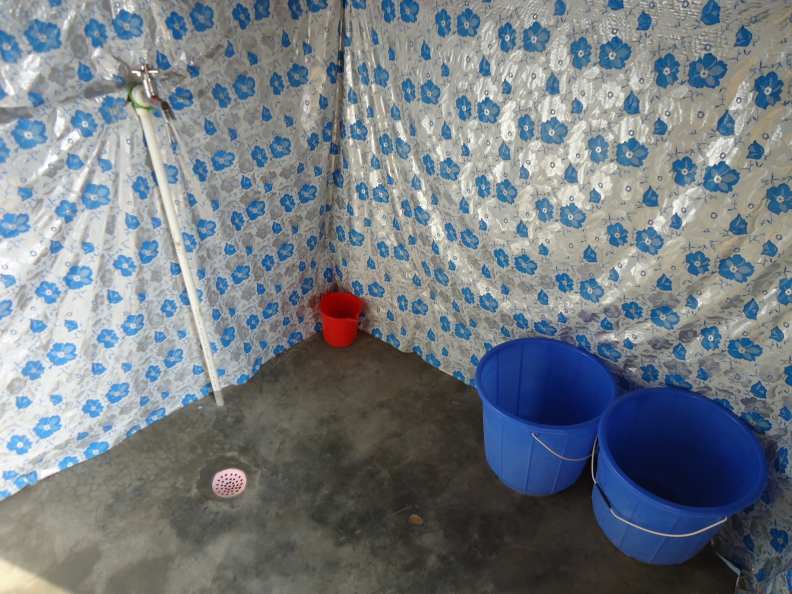AS PUBLISHED IN YOGA NATION
You Really Can Get Attached to Anything
It’s been an interesting process of getting used to living outside in India.
The huts are exactly the same
“Living” means: sleeping, changing, writing, reading, resting, bathing, and answering nature’s calls IN STRAW HUTS. We have real flush toilets (as opposed to squat toilets), buckets for “showering,” and outside sinks (which makes for chilly teeth brushing in the pre-dawn hours when we stumble off to meditation).
There was never any soap at the sinks
“Outside” means: we have the illusion of privacy as well as some real shelter. That illusion is worth a lot.
But the huts are not warm. And many leak. We’ve had several loud and violent storms to test out their waterproofness—and mudproofness and damproofness. I’d give them about 50/50.
Inside our straw castles. Four to a hut! Mosquito nets strung between bamboo poles; industrial green carpet (over straw over mud) keeps out the worst of the damp.
You know a lot about your “eco hut”—and yourself— after two days of torrential rain in an area that is not supposed to have rain as the clay earth sluices down the paths and makes a mud dam in front of your hut.
A strip of yellow silk in the doorway brightens up our huts
And the huts definitely do not protect us from the sounds of neighbors. Who knew that SO many people snore so loudly?
For us middle class Westerners, this way of living is a practice of austerity.
But as we’ve been reminded, for locals in Allahabad and Kajuraho, the way we are living is luxurious.
Toilets and showers
I will admit that this is a step up from tent camping. I am writing this from inside my hut, for example, sitting at a metal table with a blue plastic tablecloth stretched over it. We have metal cots off the ground, and clothes lines, plus lawn-green carpeting to protect us from mud and dust.
And one thing I know: I can get attached to anything. Anything at all.
I got attached to the readily available WiFi in Kajuraho. Even the cold, cold nights, bathing outside from a bucket was bearable if I had WiFi to make Facebook updates and write blog entries (only slightly kidding).
You haul in hot water with one bucket, mix it with cold from the spigot, then pour over you with the cup provided. Bucket bath!
That disappeared in Kajuraho. But the bucket baths and cold temperatures remained. Wah-wa.
In Kajuraho, I got attached to hut 7 where I weathered the interminable storms. Hut 7 almost flooded in the mud sluice, was crowded with 2 women from Duluth, another from Chicago, and me. It was damp and damp and damp. And damp. Then musty. My bed was both sloped downwards and tilted to the side like a permanent Tilt-a-Whirl.
Bucket bath set up–close up. Basic, basic, basic.
And yet I felt anxiety when I had to move into hut 49.
(Now the question is: what do I care whether I’m in straw hut 7 or straw hut 49?! They are exactly the same, just positioned slightly differently towards the bathrooms. Still I got fixated for a few hours on how much worse hut 49 was going to be. I had established my patterns and I didn’t want to budge. This is the stuff I came to India to deal with?!?! Answer: yes.)
But after two or three days in hut 49, I had completely forgotten about the charms of hut 7.
So it goes.
Campus gets pretty after torrential rains
Most of us have gotten comfortable with this quasi-camping set up.
Temperatures are getting warmer now and days are brighter. I don’t have to wear every single piece of clothing I brought to India when I go to bed. I don’t have to wait for a warm patch in the day to bathe (or just skip it for a few days until bathing is urgent).
I don’t mind doing laundry by hand. And every time I shower now, I’m sure to wash some undies. Life has become easier.
72-yr-old Sylvia does laundry by hand at the hot-water station
And there are some surprise boons. After all that rain, the desert campus has sprung into bloom. Ceramic pots of marigolds, cosmos, and asters line the paths and decorate the huts. The trees are sparkling green.
Birds have arrived in abundance: green parrots, eagles, sparrows, a large swallow-like bird, peacocks, neelkanth, and many many others that sing and chirp and whir. In fact, a pair of sparrows just flew into my hut!
After the rain
At night the jackals howl their mysteriously poignant songs arching back and forth across the hills. The farmers answer them with their ghostly shrieks meant to scare away nilgai—the large antelope/deer/horse-like creature that tramples crops (the male is actually blue colored).
Himalayan Institute campus, Kajuraho
Most of us have forgotten our discomfort in the straw village, our Western privileges, proving that you really can get used to anything.
Even basic luxury can be luxurious.
Sherry, Sylvia and I go into town for lunch–breaking out!
And now some people don’t want to go back to their easy showers and toilets, central heating and A/C.
You really can get attached to anything.
Kunda (fire pit) at the special banyan tree












